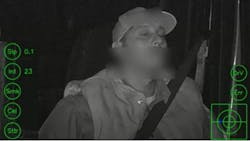Omnitracs adds drowsy, distracted detection to SmartSense system
CINCINNATI — Distracted driving continues to plague U.S. roadways, killing nearly nine people per day in motor vehicle crashes in 2019, a 10% increase over the previous year, according to the latest National Highway Traffic Safety Administration data. Omnitracs’ next generation of SmartSense uses SmartDrive technology to integrate cameras, sensors, AI, and computer vision to detect inattention and help keep drivers focused on the road.
Omnitracs, the SaaS-based fleet management and data analytics provider, just unveiled SmartSense for Inattentive Driving+, which it said can detect suspected sleep, drowsiness, cell phone usage, smoking, and general inattention. The system then sends an alert into the cab so drivers can take action to avoid potential collisions and unsafe driving. It will be available as an add-on feature for Omnitracs’ fleet customers later this summer.
“Through the artificial intelligence, the machine learning, the computer vision of the actual camera itself, we can clearly articulate the difference between inattention and drowsiness,” Ayron McLochlin, Omnitracs vice president of sales, said during the National Private Truck Council annual management conference and exhibition. “Where that’s really important is the type of coaching interaction you do with a driver. If they’re picking up a cell phone—or any other general inattention—it is one thing, but if a driver is falling asleep or they are asleep, the drivers, as well as the companies, want to know because everyone wants them home safe.”
Drowsy driving
Drowsy driving, as NTHSA calls it, led to 697 deaths on the road in 2019. The administration said that most often, drowsy-driving crashes occur between midnight and 6 a.m., usually with a lone driver behind the wheel without any passengers, and on rural roads and highways. All of those instances could describe the working conditions of professional fleet drivers.
SmartSense for Inattentive Driving+ detects and proactively notifies drivers when they are distracted or drowsy, sending immediate in-cab feedback for fleets large and small. According to Omnitracs, the software uses AI and sensor data to instantly and accurately identify inattention based on head position, eyelids being open or shut, and direction of eye gaze, phone use, etc.
SmartDrive, which Omnitracs acquired in 2020, updated the SmartSense platform last summer to include capabilities that can detect when a truck is traveling too fast for conditions and when a truck is stopped or parked in an unsafe location, which it calls SmartSense for Sitting Duck. The current and future SmartSense technology works off 20 years’ worth of training and informing sensors using insights and data from more than 300 million analyzed driving events logged across more than 30 billion miles in various transportation sectors.
McLochlin said customers are excited about SmartDrive becoming part of Omnitracs. “We get a lot of good vibes about the combination between Omnitracs and SmartDrive and what the future holds between the two organizations,” he said. “There are a lot of synergies there. They can really help our customers and help our customers be able to grow with the technologies and get more return on investments.”
Distracted driving
There were 3,142 distracted-driving-related deaths recorded on U.S. highways in 2019, according to the latest NHTSA data, which jumped 9.9% from 2018. “Distracted driving is a pandemic in itself,” McLochlin said. “We want to make sure fleets are safe. We want to make sure drivers are safe. Drivers want to make sure they’re safe.”
As the technology capabilities in driver assistance and observance grow and become more readily accepted by drivers, McLochlin said that Omnitracs wants to “lean in with a way to be able to clearly articulate between inattention and drowsy or asleep.”
He said you want to coach drivers differently depending on the distraction. "If a driver is falling asleep, you want a much more aggressive type of alert in the cab to wake them up—because nobody wants to fall asleep while driving.”
Using two cameras built into a single unit, Inattentive Driving+ offers visibility of the entire cab and details of the driver’s face, eyes, and hands to identify drowsiness, sleep, phone use, cigarette use, seatbelt use, and other safety-critical behaviors.
The technology enhances the risk detection that is already built into the SR4, the hardware created by SmartDrive that includes cameras, sensors, and controller that supports onboard driver systems and computer-vision technology. In addition, the solution can be updated over the air, and Omnitracs said it is easy to install. The system also offers wide-angle and zoom-in views that provide context, so detection can be tied to the overall safety program, aiding in determining if systemic issues need to be resolved, such as lack of sleep due to a medical or family problem.
This story first appeared on FleetOwner.
About the Author

Josh Fisher
Technology Editor
FleetOwner Editor-in-Chief Josh Fisher has been with Endeavor's Commercial Vehicle Group since 2017, covering everything from modern fleet management to operational efficiency, artificial intelligence, autonomous trucking, regulations, and emerging transportation technology. He is based in Maryland.
